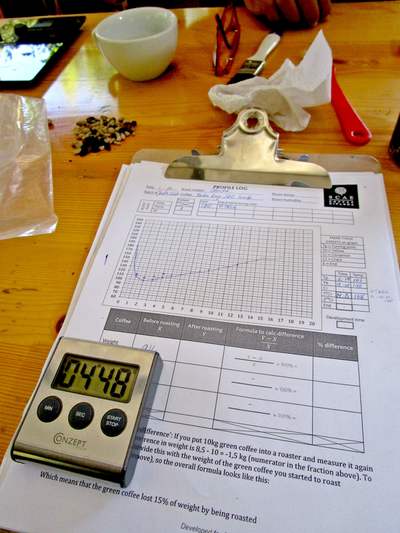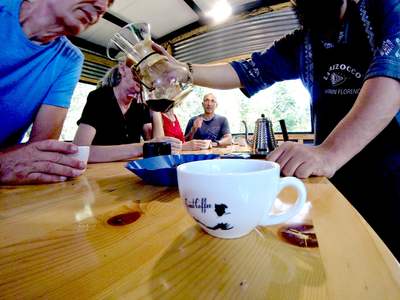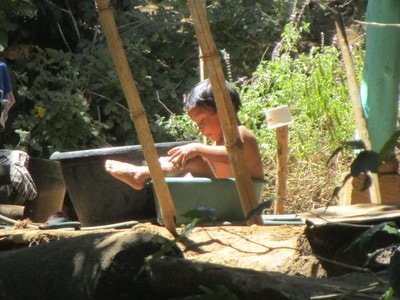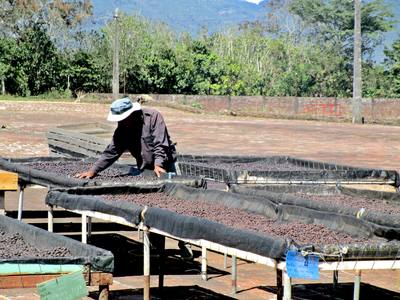|
My friend messaged me to ask; “So are you now a converted coffee drinker?” I said; “Yes, so long as I know the farmer personally, have met the bean pickers, was in the truck when the beans were transported to the mill and watched a professional make the coffee after he roasted the beans.” Actually, it was pretty easy to check off the list of requirements in my present situation & here’s how that happened. Sometimes you just drive right into things. I’d just crossed the boarder from Guatemala to El Salvador in route Ushuaia Argentina from Canada on my motorbike. I had my gps set for some hot springs to spend the night, along the famed Routa de Las Flores (Flower Route) a couple hours into the country. Having been distracted by the scenery, managing to completely overlook my stop I ended up in Juayua, a small town set in the volcanic hills of specialty coffee country. Within a couple days I was helping roast beans with the manager from one of the local boutique organic farms, from there I was invited to learn about all things coffee and I decided to stay for awhile to soak up more about the bean. Like a bad religion or a cute girl, the more I saw & learned about the specialty coffees the more I wanted to convert. People, it helps to be surrounded by the right people. This was the perfect environment to convert a coffee atheist like myself that coffee was king; it had people I could relate to\ business wise and people I liked socially. The entrepreneur, Cesar who owned the farm was tall & skinny with short curly hair, he took to wearing a half groomed five o’clock shadow and a pair of blue beat up dress boots with anything from boarder shorts to social pants. I'd put Cesar somewhere in his late thirties and had the usual entrepreneurial attention span I know very well. Cell phone in one hand chattering away, the computer turned on smashing out quick replies, chiming in on conversations in the room in two languages and hands that seemed to always be playing imaginary drums when things got briefly dull. He also kept a steady supply of coffee junkies and experts hovering about him. Over my six week period there I met a member of ‘Team Greece’, the team responsible for once winning the IBRIK world championship, they were in town looking for coffees. A number of “very important buyers” from places like Japan, Panama and Europe. A publisher for a U.K. coffee publication of varying quality and a number of various other coffee who’s who, he and this place were all things coffee. Meet my teacher. The manager of the Lechuza coffee project and hotel I was staying at would be my teacher for the month and a half I was willing to learn. Javier was in his late twenties, about five foot seven, stocky with a full jet black beard covering down his neck, enjoyed a plethora of hats and usually sported one of many comical shirts, like the got milk spin off “got pupusas?” He was extremely friendly and kept a rotating supply of neighborhood friends stopping in and out of the hotel we worked at. He was a man of varied knowledge and if anything was an artist by trade. Javier told me that before this he was once living homeless in Guatemala City with a group of artists who would spray paint art in the streets of the city. At one time his art caught the eye of a local drug lord who had him decorate four walls in the room of his house differently to represent each of his four mistresses. The drug lord loved his work and “looked after him well” making sure he enjoyed himself while he was in Guatemala. The natural progression from homeless artist was then to university studying to be a medical Doctor for several years then switching to chemistry where he had learned the process to make meth then abruptly abandoned all of that to pursue a love of coffee. From here he and a friend had opened up a well positioned yet discrete coffee shop in Santa Ana where he explained they were trying to educate the people of El Salvador about what excellent coffee they have and get them to drink the coffee they deserve opposed to the instant coffee they could usually afford. It in itself was a tall order. Coffeeoholics? Yes it’s a thing. Between the two of them and the company they kept I saw what was to be my first sighting of specialty coffeeoholics drop everything and frantically get excited when someone would come bursting through the door of the hotels coffee shop with a zip lock bag of some sample roasted beans from god knows what little farm in the middle of nowhere. Someone had heard they had a taste profile of rich caramel & black liquorice that was rounded out with burnt orange peel. Really it was astonishing to watch. After several minutes of 440g of hot water clawing away the flavors from the 33g of fresh ground beans through a filtered Chemex you could see the pupils dilate in the eyes of the anxious coffeeoholics awaiting their fix. The coffee was dark and shimmery like the hair of Jasmine in Aladdin and crept across my taste buds nailing all the aforementioned flavors, damn these guys were good. One of the most expensive coffees in the world. Another evening after we’d brewed up a batch of beans off the shelf for some lovely American tourists, they got to asking questions about the brew. When their batch had finally all come dripping through the filter it looked more like orange pekoe tea and smelled like flowers then any brew I’d ever laid eyes on before. The taste could only be described by many as “soft and aromatic with light fruity notes” unlike anything anyone had tasted before. Well the questions led to some answers about an El Salvadorian farmer who had harvested the original beans and Javier showed us the write up on this particular coffee. Turns out it was #9 of the most expensive coffees in the world. An Asian buyer had stumbled across it in 2013 and couldn’t believe his taste buds, he paid $50/ pound for the green bean and bought the whole crop. Currently they had a kept few beans from that farm in the shop to sample and now I have a pound tucked in my motorcycle luggage, your welcome Amanda & Angie! How we spent the days with the beans. I spent the weeks shadowing personalized coffee tours hosted by Javier for Lechuza Café soaking up all things specialty coffee. We covered the spectrum from bean development altitude and how the denser strictly high altitude or any bean growing over 1200meters would typically yield a better, denser bean, like Lechuzas Finca Limon that grew at 1640m. How the farm would specifically plant things like mango, oranges and avocado, as shade for the bean and to uniquely influence the flavour. Often we’d go to the mill and unload organic beans to be dried in African beds with the cascara on for a honey finish that would sweeten the bean while it dried. Some days I would help sort green beans for various selections from American to European to even a zero defect coffee. We would literally be hand inspecting each bean for the certain number of defects it was allowed. The bean separation took place in a hot little room in the coffee warehouse that was dreadfully boring and not recommended hung over. The bean was being hand planted, hand groomed, hand picked, hand dumped and spread in the African bed, hand turned every hour during sunlight for roughly sixteen days to %12 humidity, ran through a trilla by hand to remove the cascara and parchment then picked through by hand to ensure quality. It was then small batch roasted by hand, only to later be hand brewed in batches of 1-4 cups. This was by far the most carefully oversaw process for quality I’ve ever been apart of in my life. Some of these would come from Lechuzas Jardin de Pacamara the crop that won best espresso shot in the 2016 El Salvador Barista Championship. You would think it would be the farmer who was charging more per liter then gasoline not the final brewer. You think you could convert a coffee atheist? Heck we even covered how crap coffee was handled so you could see the difference. One day Javier was giving an explanation about how all these beans that were laid out across cement in the mills yard to dry & would dry way above the 28oC that was optimal. At the most perfect of moments two men started walking across the beans in their running shoes to go talk to some other guys. Javier laughed and said there could be anything on those shoes and it would eventually make its way into instant coffee. Hope you’re not enjoying a nice insta-brew right now. The astute quality control that eventually landed in the cups I drank was unlike any other coffee I’d ever sampled in my entire life. It felt more like angles had used their wings to filter the heavenly beans grown to mirror the flavors of earths most unique creations and combinations. If my tongue had been blessed this way originally rather then scarred by muddy cups of commercial Joe it wouldn’t have taken two decades to make me a believer. Look out rare specialty crops; I’m coming for ya… +++ Whats that last photo you ask?
Well when you have premium specialty coffee and no way to brew it, one simply takes a beer can and cuts it in half, punches some holes in the bottom and adds a paper filter! Ohh man I feel the guy who originally bought the whole crop would not be impressed :))
0 Comments
Leave a Reply. |
Copyright © 2023 KIXMARSHALL.COM





















